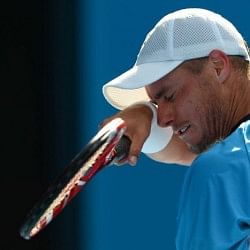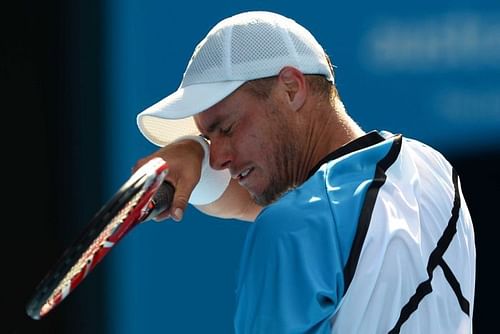
Lleyton Hewitt: Changing times, changing constancies

Lleyton Hewitt made his debut appearance at the Australian Open main draw in 1996.
When Lleyton Hewitt won his first major back in 2001, I was in eighth grade preparing for my half-yearly exams. That was nearly 15-years ago and a lot of things have changed in the years that have passed, while equally there have been some, which have remained constant, unchanged.
Lleyton Hewitt, in many ways, is still a constant. At the same time, there are many things revolving around him that have changed through the passage of time. His fighting spirit remains distinctive as ever, but where in the past his resilience doubled up as an effective arsenal to his game, these days his resiliency has often been left stranded in the wake of his weakened body.
Not that one can complain much about it; for it’s obvious to everyone who’s been following Hewitt’s game about the changes that have been wrought by the numerous injuries and illnesses that have plagued him over the years. Though his comebacks have been phenomenal displaying the Australian’s grit over and over again, they have been proof that Hewitt’s talent has been slowly eroded by his own physical self with his game unmistakably changed to ensure the least possible stress to his body.
Despite all these, Hewitt still remains a crowd puller. His fans rejoice to see him play; it’s as if the intervening years between post-2002 and now never came to pass. Each tournament that he plays attracts his foul-weather ‘Fanatics’ whose chants of ‘Let’s Go Rusty’ keep the momentum going off-court even if the momentum on it slips a bit. There isn’t much expectation from them beyond expecting their hero to put on a good show for them to remember; where other fans expect their idols to win outright, Rusty’s fans keep their optimism restricted towards him being fit and injury-free.
Those rare moments when he does win titles, like in Halle in 2010 and more recently in Brisbane earlier at the start of this season, their ecstasy is uncontrolled. And it is in these rare moments that their wave of optimism gets the best of their cautiousness, like after Hewitt’s victory over Roger Federer in the Brisbane final which raised their hopes for him to emerge as the dark horse for the Australian Open.
Hewitt’s presence in the Australian Open this year was made even more special by the fact that he was making his 18th consecutive appearance at the tournament, a level of consistency not even his hardest critics would belittle or toss around carelessly. Then there was the surprise of him teaming up with Patrick Rafter, accepting a last-minute wild card to play in the doubles. It enlivened things up a bit, giving not just Hewitt’s fans, but also Rafter’s fans a chance to see two of their most successful prodigies in the contemporary era pair up.
That’s a reason why, prior to the start of Hewitt’s first round match against Andreas Seppi, the numerals mentioned next to the Italian’s name denoting his ranking didn’t seem daunting. It wasn’t taken lightly, but neither did an opening round loss seem imminent. There was a chance that Hewitt could progress further into the draw rather than make an early departure like in the previous year.
As the match progressed, watching him fight-back and lose – points, games and sets – expectations did start to dwindle a bit. The chants still lingered, perhaps even more vociferous, egging him on as they always do whenever his game starts to slacken. Two sets down, it was as if the Italian had all the answers to the tennis pop quiz named Lleyton Hewitt, while the latter seemed clueless, not capitalising on opportunities even when they kept coming his way.
There were groans, there were frustrated exclamations and the trademark fist pump barely made an appearance, but never at any point did anyone believe that Hewitt was going to lose.
It’s in moments like these that the nickname ‘Rusty’ comes across as ironic and paradoxical than at any other time. And it’s in moments like these that Lleyton Hewitt the fighter comes back into play, as if waking up from a deep slumber. Sets three and four sparked definite comebacks, serves that were broken were broken back, the aggression was there in Hewitt’s demeanour as was the zest on the faces of his fans whose recitations became even more pronounced.
To see Hewitt finally lose in the 12th game of the fifth set – after having broken back Seppi in the eighth game – was disappointing. But as saddening as it was to see Hewitt end up on the losing side after having played so spiritedly, the chance to see him play on the doubles front gave enough reasons about him to cheer.
But Hewitt’s doubles first round match, partnering Pat Rafter against Eric Butorac and Raven Klaasen, was a much shorter affair unlike his prolonged battle against Seppi. Butorac and Klaasen exploited the last-minute partnership, appearing more seasoned and well prepared. So much so that by the end of the first three games it became clear that the Australian wild-card team wasn’t going to do much damage to the American-South African team despite doing their best.
And that’s yet another thing that’s changed when it comes to Lleyton Hewitt – he’s been relegated from being a long-term find for tennis into an unintentional stop-gap for the sport to move on.
Back in my school days and early college days, before injuries started claiming Hewitt for their own, I used to hear a lot about him being the biggest and brightest star in the future of men’s tennis. Before Roger Federer became the ‘it’ factor in tennis, before Marat Safin had even given a glimpse of what he was capable of doing and before Andy Roddick raised the American hopes, Lleyton Hewitt’s name marked all the ‘tomorrow’s’ in men’s tennis. And as I remember this facet of information, I also remember how over the years his name – always taken in context to long-term achievements – morphed into a reference for short-term success, overshadowed by circumstantial adversities.
The change in the outlook from ‘will-do-well-in-the-Australian-Open’ to ‘not-crashing-out-in-the-doubles-at-least’ took just a couple of days. As curtains fell on Hewitt’s appearance in his 18th successive Australian Open, most people, including his fans, had started to look towards the future. A future in which Hewitt’s inclusion was very pointedly questioned, as if to determine whether his presence would be a constant for another year or a change which had to be prepared for, right in the immediate short-term.